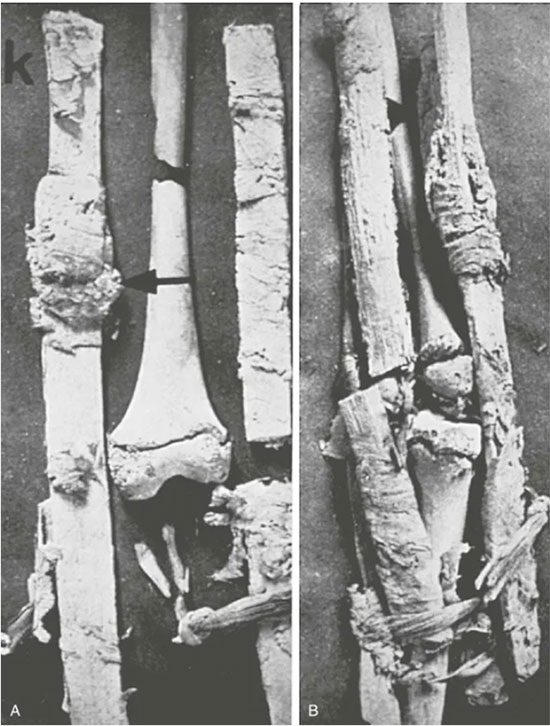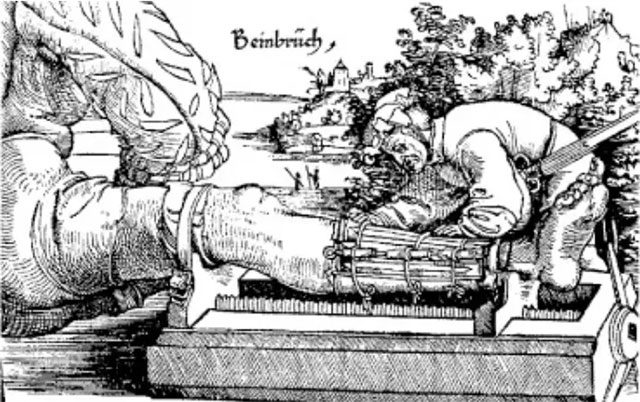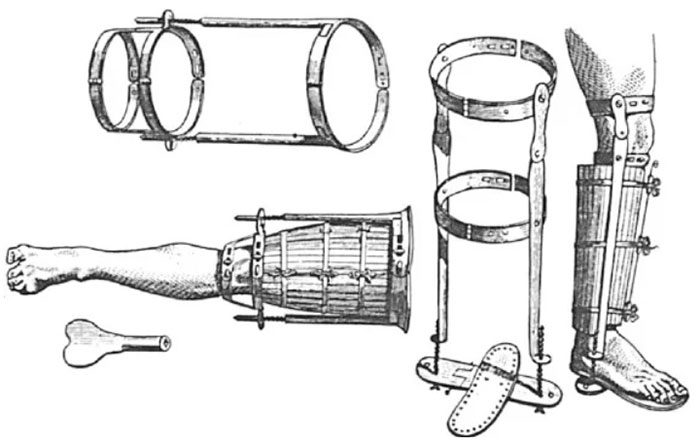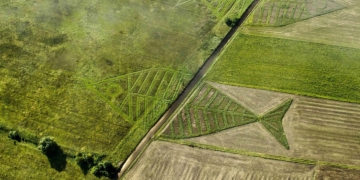Currently, modern medicine for treating fractures often uses metal plates for stabilization, steel pins, or casts for immobilization. However, ancient Chinese medicine had miraculous and effective methods for treating broken bones.
The first method dates back to 3000 BC when ancient Egyptians used wooden splints made from bark wrapped in linen to support fractured limbs. They also employed hard powders similar to those used in mummification techniques. Meanwhile, ancient Hindus used bamboo splints for similar purposes.
In the 30s AD, a Roman scientist named Celsus described a technique using splints and a hard bandage made from corn starch to treat fractures. Additionally, ancient Greeks utilized wax and resin to harden bandages. Furthermore, lime derived from shell and egg white was also used by Arab physicians in their casting practices.

A and B, juvenile femur fracture specimens dating around 300 BC, excavated at Naga-ed-Der (Egypt) in 1903. This is a juvenile femur with a mid-shaft fracture, stabilized with four longitudinal wooden splints, each wrapped in linen bandage.
Using Willow Branches for Bone Connection
Phó Thanh Chủ – one of the six famous physicians of the Ming and Qing dynasties, once wrote about the case of using willow branches to reconnect bones in “Jin Zhen Du Shi.” The physician cut a willow branch, peeled its bark, and shaped it to match the bone. He then cut and ground the fractured area of the bone and the willow branch to fit together, applying boiled chicken blood to the ends of the willow branch at the fracture site, placing the branch in the middle to replace the broken bone.
After positioning the willow branch, the physicians would sprinkle finely ground azurite onto the muscle tissue to promote bone and muscle growth. Finally, the physician sutured the incision, applied a cast, and secured it with a wooden board to stabilize the fracture.

Illustration of using wooden splints from Gersdorf (1517). The doctor is attempting to tighten the splints with ties.
In ancient times, the willow tree played a crucial role in healing and gradually became a part of… human bones.
Using Natural Copper Elements to Promote Bone Healing
In ancient times, there were no microscopes or tools to differentiate between various metal elements, but according to records from the Tang dynasty medical book “Bencao Shiyi,” physicians at that time discovered that natural copper helped in the recovery and growth of bones. Therefore, for those with fractures, physicians recommended using natural copper.

Various forms of wooden splints used for bandaging injured limbs have been utilized since ancient times to the present.
Natural copper, also known as “tian tui yuan” or cubic copper, is one of the medicinal substances in traditional Chinese medicine, derived from natural iron ore, with its main component being FeS2.
In traditional Chinese medicine, it is primarily used to treat fractures, effectively reducing blood stasis, alleviating pain, and reconnecting bones and tendons. The main preparation method involves using vinegar that has been processed seven times.
Modern medicine has discovered that natural copper can promote the increase of reticular cells and hemoglobin in bone marrow, helping to accelerate bone healing. However, how did traditional Chinese medicine recognize this thousands of years ago? Perhaps we also need time to study the profound mysteries of traditional medicine.



















































